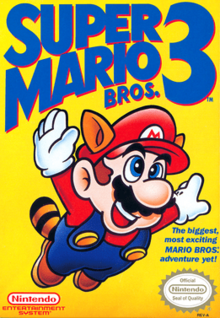
Back سوبر ماريو برذرز 3 Arabic سوبر ماريو بروس. 3 ARZ Super Mario Bros. 3 Byelorussian Super Mario Bros. 3 Catalan سووپەر ماریۆ برۆس ٣ CKB Super Mario Bros. 3 Danish Super Mario Bros. 3 German Super Mario Bros. 3 Greek Super Mario Bros. 3 Esperanto Super Mario Bros. 3 Spanish
| Super Mario Bros. 3 | |
|---|---|
 North American box art, depicting Mario using the "Raccoon Mario" power-up | |
| Developer(s) | Nintendo R&D4 |
| Publisher(s) | Nintendo |
| Director(s) | |
| Producer(s) | Shigeru Miyamoto |
| Designer(s) |
|
| Programmer(s) | Toshihiko Nakago |
| Artist(s) |
|
| Composer(s) | Koji Kondo |
| Series | Super Mario |
| Platform(s) | Nintendo Entertainment System, arcade (PlayChoice-10), Game Boy Advance |
| Release | FamicomPlayChoice-10
|
| Genre(s) | Platform |
| Mode(s) | Single-player, multiplayer |
Super Mario Bros. 3[a] is a 1988 platform game developed and published by Nintendo for the Nintendo Entertainment System (NES). It was released for home consoles in Japan on October 23, 1988, in North America on February 12, 1990, and in Europe on August 29, 1991. It was developed by Nintendo Entertainment Analysis and Development, led by Shigeru Miyamoto and Takashi Tezuka.
Players control brothers Mario or Luigi, who must save Princess Toadstool and the rulers of seven different kingdoms from the antagonist Bowser. As in previous Mario games, they defeat enemies by stomping on them or using items that bestow magical powers; they also have new abilities, including flight and sliding down slopes. Super Mario Bros. 3 introduced many elements that became Super Mario staples, such as Bowser's children (the Koopalings) and a world map to transition between levels.
Super Mario Bros. 3 was praised by critics for its challenging gameplay and is regarded as one of the greatest video games of all time. It is the third-best-selling NES game, with more than 17 million copies sold worldwide. It also inspired an animated television series, produced by DIC Entertainment.
Super Mario Bros. 3 was remade for the Super NES as a part of Super Mario All-Stars in 1993 and for the Game Boy Advance as Super Mario Advance 4: Super Mario Bros. 3 in 2003. It was rereleased on the Virtual Console service on the Wii U and 3DS, and was included on the NES Classic Mini. On September 19, 2018, it was rereleased on the Nintendo Switch Online service with added netplay.
- ^ "Wii U Super Mario Bros. 3". Nintendo. Archived from the original on August 17, 2014. Retrieved June 28, 2014.
- ^ "Super Mario Bros. 3 International Releases". Giant Bomb. Archived from the original on July 16, 2014. Retrieved June 28, 2014.
- ^ "The history of Super Mario". mario.nintendo.com. Archived from the original on February 1, 2021. Retrieved September 3, 2020.
- ^ Knorr, Alyse (April 27, 2016). "The Making (And Legacy) Of Super Mario Bros. 3". Kotaku. Archived from the original on September 27, 2020. Retrieved March 20, 2020.
- ^ "Super Mario Bros. Developer Interview". Archived from the original on January 1, 2017. Retrieved December 9, 2016.
Cite error: There are <ref group=lower-alpha> tags or {{efn}} templates on this page, but the references will not show without a {{reflist|group=lower-alpha}} template or {{notelist}} template (see the help page).